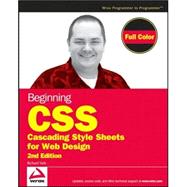
Note: Supplemental materials are not guaranteed with Rental or Used book purchases.
Purchase Benefits
What is included with this book?
| Acknowledgments | |
| Introduction | |
| Introducing Cascading Style Sheets | |
| Document Standards | |
| The Basics of CSS Anatomy and Syntax | |
| Data Types, Keywords, Color, Length, and the URI | |
| CSS Selectors | |
| Pseudo-Element and Pseudo-Class Selectors | |
| Inheritance and the Cascade | |
| Text Manipulation | |
| Font Manipulation | |
| Liquid Design and the CSS Box Model | |
| CSS Buoyancy: Collapsing Margins, Floating, and Vertical Alignment | |
| Styling Lists and the User Interface | |
| Backgrounds: Setting the Scene | |
| Positioning | |
| Styling for Handheld Devices and Print | |
| Styling Tables | |
| Styling XML | |
| Cross-Browser Compatibility | |
| Exercise Answers | |
| CSS Reference | |
| CSS Colors | |
| Browser Rendering Modes | |
| Index | |
| Table of Contents provided by Publisher. All Rights Reserved. |
The New copy of this book will include any supplemental materials advertised. Please check the title of the book to determine if it should include any access cards, study guides, lab manuals, CDs, etc.
The Used, Rental and eBook copies of this book are not guaranteed to include any supplemental materials. Typically, only the book itself is included. This is true even if the title states it includes any access cards, study guides, lab manuals, CDs, etc.